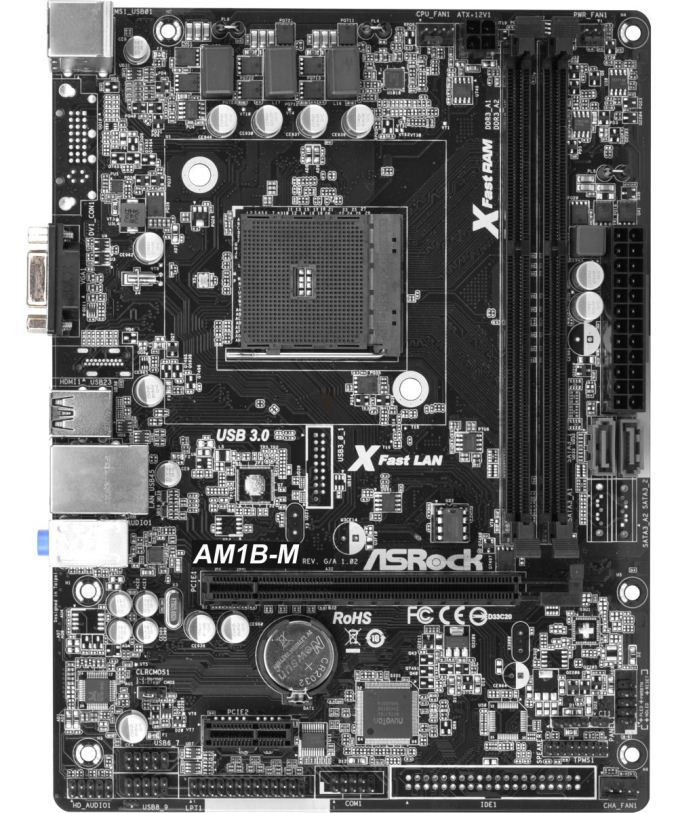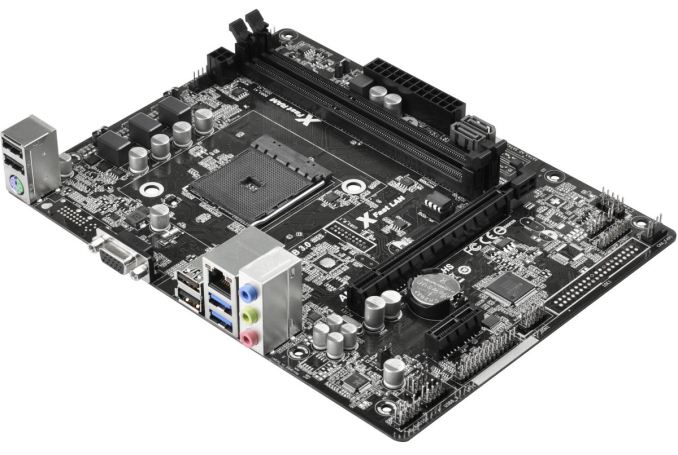The AM1 Kabini Motherboard Preview: Analyzing the Hardware
by Ian Cutress on April 19, 2014 2:00 PM ESTASRock AM1B-M
ASRock’s first motherboard falls under the $40 mark and also represents a slightly different variation on the theme. So far no two motherboards have been alike, and the ASRock AM1B-M exchanges the higher audio and video outputs instead for more rear USB 2.0 ports and an extra fan header. On the face of it, this does not seem like a good deal compared to the previous MSI, unless you need extra USB 2.0 ports.
The AM1B-M seems to have a lot of spots unoccupied by connectors. This is mostly likely due to variations of products, where the cheapest tends to have expensive connectors removed to hit a price point. We see two SATA ports missing, an IDE pin layout but no connector, and also a DVI connection missing on the rear panel. In the middle of the board is also a USB 3.0 pin layout, suggesting that another model has an additional USB 3.0 controller as well.
What the ASRock AM1B-M also does differently to all the motherboards we have examined before now is include a COM port, LPT port and a TPM port on the same PCB. It would be interesting to see which niche that combination would be good for.
The PCIe layout uses the PCIe 2.0 x4 from the chipset in a full sized slot, with an additional PCIe 2.0 x1 underneath. Thankfully the SATA ports are alternate facing for removing locking SATA cables, and the placement of the 4-pin CPU connector also helps cable routing. The AM1B-M has three fan headers, one more than the others – two on the top of the motherboard either side of the DRAM slots, and a third on the bottom right.
The AM1B-M has four USB 2.0 ports on the rear panel, or what I like to call my happy minimum (installing an OS via USB helps with at least three USB 2.0 ports). That being said, the sole VGA connector looks lonesome, and the ALC662 audio codec is not a particularly good choice.
| ASRock AM1B-M | |
| Price | Link |
| Size | Micro-ATX |
| CPU Interface | FS1b |
| Chipset | Kabini |
| Memory Slots |
Two DDR3 DRAM slots, supporting 16GB Single Channel, 1066-1600 MHz |
| Video Outputs | VGA (2048x1536 at 60 Hz) |
| Onboard LAN | Realtek RTL8111GR |
| Onboard Audio | Realtek ALC662 |
| Expansion Slots |
1 x PCIe 2.0 x16 (x4) 1 x PCIe 2.0 x1 |
| Onboard SATA/RAID | 2 x SATA 6 Gbps |
| USB 3.0 | 2 x USB 3.0 (Chipset) [rear panel] |
| Onboard |
2 x SATA 6 Gbps 2 x USB 2.0 headers 3 x Fan Headers 1 x TPM Header 1 x LPT Header 1 x COM Header Front Panel Header Front Audio Header |
| Power Connectors |
1 x 24-pin ATX 1 x 4-pin CPU |
| Fan Headers |
1 x CPU (4-pin) 1 x CHA (4-pin) 1 x SYS (3-pin) |
| IO Panel |
1 x PS/2 Combination Port VGA 2 x USB 3.0 4 x USB 2.0 1 x Gigabit Ethernet Audio Jacks (ALC662) |
| Product Page | Link |














64 Comments
View All Comments
JFish222 - Monday, April 21, 2014 - link
I agree, its disappointing that there is no ECC. (At least not listed.)I was really looking forward to using one of these for a low cost FreeNAS box.
Ian, Anand and company. Please encourage ECC bios support/validation! If any of the manufacturers support it (not always obvious when they do) please point it out.
For those that don't understand the importance, ZFS has numerous benefits but its greatest weakness is the ability to corrupt the entire data pool due to a flipped bit or 2 in RAM.
For more info - http://forums.freenas.org/index.php?threads/ecc-vs...
Chicken76 - Monday, April 21, 2014 - link
Indeed, Anandtech has the ear of motherboard manufacturers. They might respond positively if such suggestions are properly argumented. There's not only the enthusiast home user that these might be useful to, there's also the small businesses sector, where cost is a deciding factor. Add ECC support and a bit of validation for production use, and a lot of the cost-conscientious businesses will refresh their storage boxes and low workload machines using Kabini, instead of the Pentiums and Celerons they use now.rogueninja - Sunday, April 20, 2014 - link
Only bad friends recommend AMD.meacupla - Sunday, April 20, 2014 - link
Currently, AMD's most attractive CPU parts are the $60 A6-6400k and $120 FX-6300.Pentium and i3 have more single thread computing power, but looking at the entire package, AMD has some advantages at those price points.
Like a cheap 8 port SATA mobo, you can't have that with cheap LGA1150 boards.
or having 6 physical cores.
Antronman - Monday, April 21, 2014 - link
Except that when you're on a low budget, AMD is the only thing you should be recommending.Ortanon - Tuesday, April 22, 2014 - link
Intel usually wins low-budget too, haha. If you're talking "best gaming performance at the absolute bottom," yes, AMD wins. But who wants to game down there? As soon as you try to add any performance to your build whatsoever, it turns into an Intel solution with a PCIe GPU. It's possible that this would be different if all software was highly-threaded, but it just doesn't work out that way.AlB80 - Sunday, April 20, 2014 - link
Gigabyte's mobo has heatsink. What behind it? SuperIO?DuckieHo - Monday, April 21, 2014 - link
Biostar's mITX-Plus..... isn't that just AMD's DTX form factor?JBVertexx - Monday, April 21, 2014 - link
Stumbled across this - PC build in the motherboard box:https://www.youtube.com/watch?v=xngzjrKg3zI
WeatherDave - Monday, April 21, 2014 - link
"COM port, LPT port and a TPM port on the same PCB"We have about 50 machines here. Mostly for embedded testing, such as stepper motors, and old equipment that ONLY connects via Serial Port. USB converters are both unreliable and prone to failure, so we like having the COM ports on board. Besides, Windows 98/2000 and XP much prefer them over a converter. Now, we don't have much use for the LPT, but TPM and a cheap SSD certainly keeps IT Security off our backs.